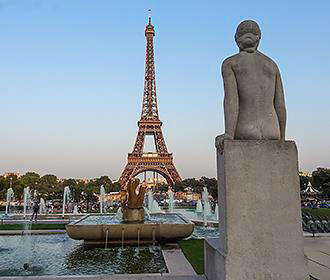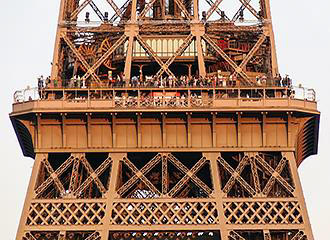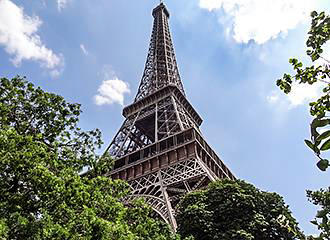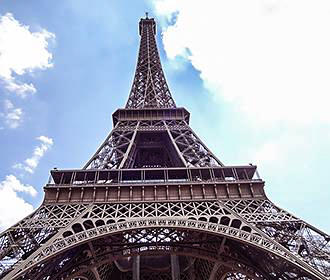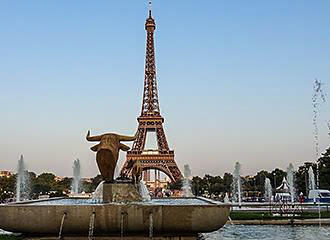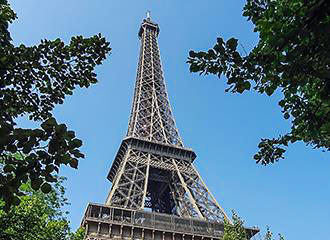Paris Eiffel Tower history starts back in 1887
It all started when the Journel Officiel launched a competition to study the possibility of erecting an iron tower on the Champ de Mars for the 1889 Universal Exhibition that would be as a monument for the centenary of the French Revolution.
Out of a total of 107 different entries submitted for the competition, it was the project proposal by the entrepreneur and talented engineer Gustave Eiffel that won the competition, which was his overall best achievement in all the buildings and construction work that he designed.
Incredibly, around 5,300 drawings were produced by 50 designers and engineers in order to come up with the final details for all aspects of the tower, even though it was only meant to be in place for 20 years.
Gustave Eiffel decide to use iron for the construction of the Eiffel Tower, as it is far more resistant than other materials like wood, yet it is reasonably light weight and can be supported with smaller foundations, as the load would not be much greater than that of a standard Paris house.
However there was much controversy and many people did not like the idea of this tower, calling it a monstrosity and much worse, but Gustave Eiffel had lots of ideas of how the tower could be utilised, such as scientific experiments, but it was the science and communications at the Eiffel Tower that really made its mark.
But lets get back to the construction..
Work on the tower began in the January of 1887 and there were over 100 workers that built over 18,000 parts in a workshop, whilst another 100 plus workers put the parts together on site at Champ de Mars.
But of course it all has to start with foundations, and again, starting in the January, it took workers around five months to dig the foundations just using spades, with the rubble being taken away via horse and cart and steam trains.
However, as with many construction sites, things do not always go easily and the two pillars on the River Seine side required air-compressed foundations that utilised corrugated steel caissons that ended up 5 metres under water, yet incredibly, the deepest foundations are only 15 metres underground.
As you know, the Eiffel Tower has four pillars and each of the feet were set into the foundation ditches in concrete in order to support the pillars that are known as truss frames. But it was assembling the first floor that became a mammoth engineering achievement, as the engineers had to use hydraulic jacks and a scaffolding system with boxes of sand that were used to adjust the slant of the truss frames, so that they could be put on a slant to meet up with the horizontal beams on the first floor.
And even though these do not exist today, now when you visit the Eiffel Tower you can see replicas of the original jacks that are located on the first floor.
Actually building The Eiffel Tower was a bit like putting together an old fashioned Meccano set with everything riveted into place, and when it came to the second floor of the Eiffel Tower, each part that had been manufactured in a workshop was put into position by cranes with impeccable precision, which again was a major innovation of the time.
Then came the third floor, which is where Gustave Eiffel even had an office built for his own experiments and astronomy observations. And then came the top of the Eiffel tower, which by the end of construction the tower was a height of 312 metres, and this made it the tallest building in the world - that was until the Chrysler Building in New York beat it in 1930!
The carpenters that also worked on each floor done a spectacular job to bring everything together for the safety and pleasure of its visitors, just like the four wooden pavilions that were positioned on the first floor to house the original four Eiffel Tower restaurants.
However, as we quickly mentioned earlier, science was also one of the main points that Gustave Eiffel wanted the tower to be utilised for, and there were numerous different types of science equipment installed in the tower such as barometers, lightning conductors, wind gauges, even a wind tunnel, radio contact, Foucault’s pendulum and much, much more.
When it came to visitors being able to get up and down the tower there is yet another story..
Yes, there was a staircase to the top, which was a total of 1,710 stairs that Gustave Eiffel climbed along with Paris dignitaries, in order to plant the French flag when the tower was inaugurated on 31st March 1889. And a part of the original staircase is on show for visitors to admire.
But there were also elevators put in place, which again was a remarkable feat of engineering at that time and these hydraulic elevators at the Eiffel Tower were classed as a major technical achievement from the genius and vision of Gustave Eiffel, who left us a legacy that we take for granted today.
And not forgetting the foresight of Gustave Eiffel and communications, which also meant this famous Paris landmark in France never got demolished, and is still the most popular paid tourist attraction in the world today, but things have never stopped there.
Over the years there have been alterations to things such as the lighting, elevators and so on, with ongoing maintenance and renovations that have also had to take place over the decades, plus there have been additions and many modern improvements for an even better visitor experience. This includes being able to see a bust of Gustave Eiffel who designed the Eiffel Tower, which is located on the esplanade at the foot of the North pillar.
When the original spiral staircase was taken down in 1983, many of its sections were sold off, yet one piece at over 4 metres in height remains at the Eiffel Tower on display on the first floor, which was a part of the original spiral staircase used by Gustave Eiffel to reach the top section and his office.
One of the things that was put in place a few years ago was a glass floor on the 1st level that lets you see down to the ground and people way below you, although not for the faint hearted and those scared of heights, but lifts also have glass panels for a truly remarkable experience.
The second floor is still home to the fabulous Jules Verne top table restaurant, yet there is a buffet restaurant offering various quick meals along with a gourmet macaroon bar, plus the addition of laser engraving within the customisation store provide an opportunity to take away a completely unique souvenir or gift, not forgetting the obvious of spectacular views and viewing stations.
We mentioned earlier that Gustave Eiffel used to have his office at the very top of the Eiffel Tower, and now you can experience this as it would have been, due to it having been restored with the addition of wax models depicting the architect, designer and engineer himself welcoming Thomas Edison along with the gramophone he was presented with.
So with technologies always emerging, but history still an important part of our heritage, the Eiffel Tower continues to evolve, providing even more enjoyment to the millions of visitors it sees each year, having already celebrated its 130th birthday and always looking towards the coming decades.
